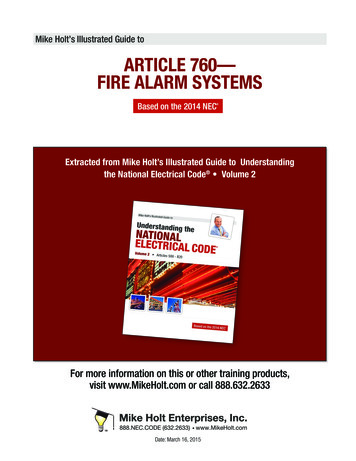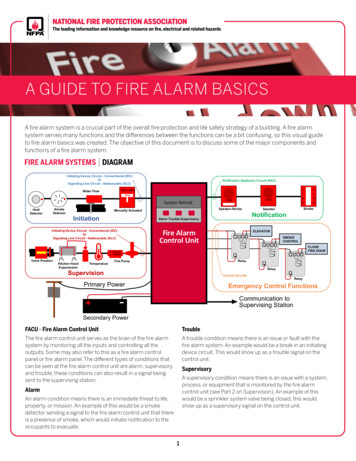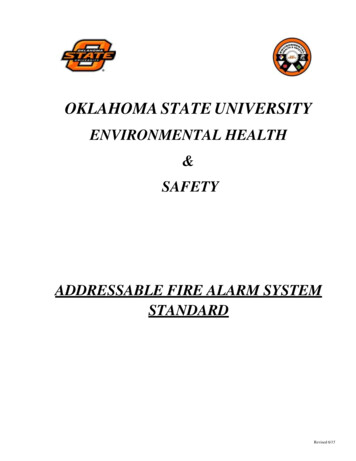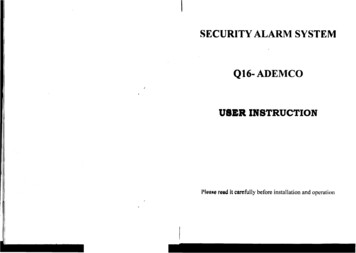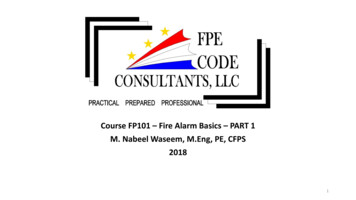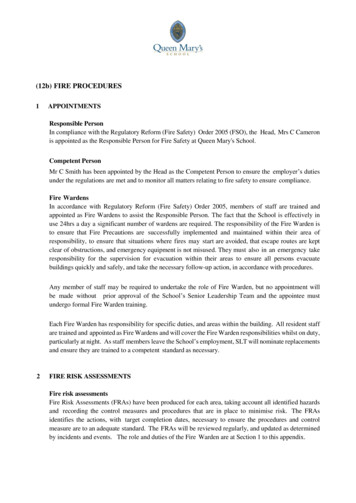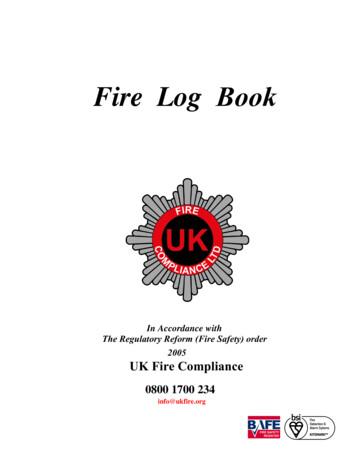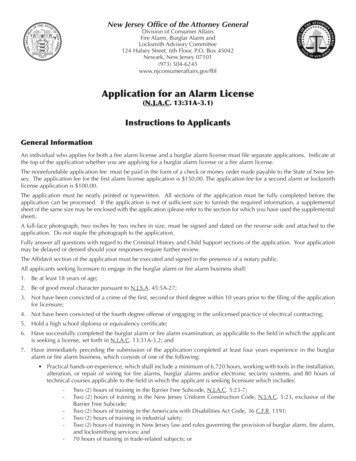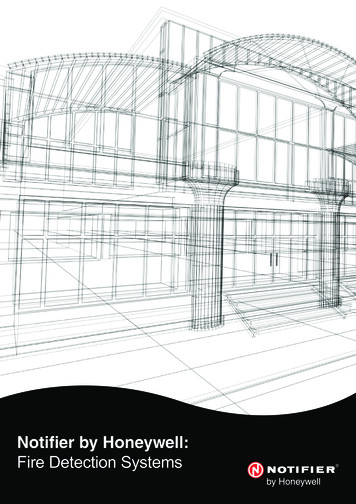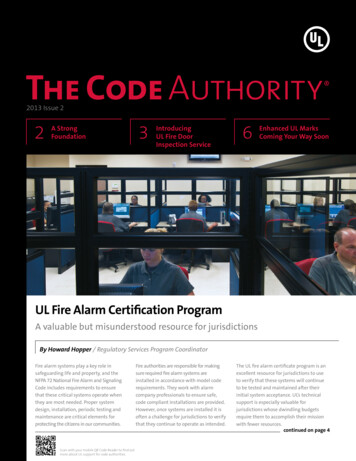
Transcription
2013 Issue 22A StrongFoundation3IntroducingUL Fire DoorInspection Service6Enhanced UL MarksComing Your Way SoonUL Fire Alarm Certification ProgramA valuable but misunderstood resource for jurisdictionsBy Howard Hopper / Regulatory Services Program CoordinatorFire alarm systems play a key role insafeguarding life and property, and theNFPA 72 National Fire Alarm and SignalingCode includes requirements to ensurethat these critical systems operate whenthey are most needed. Proper systemdesign, installation, periodic testing andmaintenance are critical elements forprotecting the citizens in our communities.Fire authorities are responsible for makingsure required fire alarm systems areinstalled in accordance with model coderequirements. They work with alarmcompany professionals to ensure safe,code compliant installations are provided.However, once systems are installed it isoften a challenge for jurisdictions to verifythat they continue to operate as intended.The UL fire alarm certificate program is anexcellent resource for jurisdictions to useto verify that these systems will continueto be tested and maintained after theirinitial system acceptance. UL’s technicalsupport is especially valuable forjurisdictions whose dwindling budgetsrequire them to accomplish their missionwith fewer resources.continued on page 4Scan with your mobile QR Code Reader to find outmore about UL support for code authorities.
[ 2013 Issue 2 ]UL-eseDefinitionsof termsfrequentlyused at ULBrand ProtectionCode authorities, consumersand retailers expect productsbearing a UL Mark to complywith applicable safety andother requirements. UL iscommitted to taking whateveraction is necessary to protectthe integrity of its MarksA Strong Foundationagainst counterfeiting andother supply chain diversions.This is done through anaggressive anti-counterfeitingprogram, and by providingguidance and strategies tohelp businesses managethe security of their supplychain and protect their brandagainst counterfeiting andgray market diversion.For additional informationon UL’s brand protection andsupply chain security advisoryservices see ces/By Howard Hopper / Managing EditorThese days most companies, jurisdictions and agencies have a missionstatement. This statement is intended to guide the actions of theorganization, spell out its overall goal, provide a path for achieving thegoal, and guide decision-making. Some organizations take theirmission seriously while others just create one that sounds goodbecause everyone else has one.As a long time UL employee I have seen our mission statement evolveover the years to account for changes in our business, our industry andsociety. But one thing has always remained constant. The UL missionhas always reflected the basic principles and values established by thecompany’s founder, William Henry Merrill, over 100 years ago.UL’s current mission includes eight elements, ranging from promotinga safe living and working environment to being a good example ofcorporate citizenship and social responsibility. It is evident to me thatthese are not merely slogans that sound good in principle but get lostin practice. The mission has always been the very foundation of whoUL is, it drives every decision UL makes.I am proud to be associated with UL, and equally proud of our mission.Check it out at www.ul.com/global/eng/pages/aboutul/ourmission/and let me know what you think.advisoryandeducation/[2]
www.ul.com/tcaIntroducingUL Fire DoorInspection ServiceBy Howard Hopper / Regulatory Services Program CoordinatorFire doors are an integral part of a building’ssafety system. During everyday use, a firedoor seems just like any other door. But whena fire occurs, these doors prevent fire fromspreading from the area of origin to otherprotected areas within the building. UL hasestablished a fire door inspection program tohelp property owners and code authoritiesconfirm that existing fire doors remain codecompliant and operational.The NFPA 80 Standard for Fire Doors andOther Opening Protectives regulates theinstallation and maintenance of assembliesand devices used to protect openings in walls,floors, and ceilings against the spread of fireand smoke within, into, or out of buildings.Section 5.2.1 requires fire door assembliesto be inspected and tested not less thanannually, and that a written, signed recordof the inspection be retained for review bythe AHJ. This requirement recognizes thatfire doors, shutters, and windows are of novalue unless they are properly maintainedand closed or are able to close at the timeof fire. NFPA 80 recommends that a periodicinspection and maintenance program beimplemented and is the responsibility of theproperty management.The NFPA 101 Life Safety Code also requirescertain doors in specified occupancies to beinspected and tested not less than annually,and the International Fire Code requires[3]openings in required fire walls, fire barriersand fire partitions to be maintained inaccordance with NFPA 80.These code requirements have led somebuilding owners and facility managers toseek qualified, independent organizationssuch as UL to conduct detailed annualfire door inspections to determine if theirbuildings remain in compliance with thepreviously referenced code requirements.Accordingly, UL established a fire doorinspection program in which UL fieldrepresentatives visit the respective locationand conduct a detailed inventory andcomprehensive inspection of all designatedfire doors. The inspection is designed todetermine compliance with all applicableNFPA 80 periodic inspection requirements.At the conclusion, a report is provided withdetails about compliance and, if applicable,reasons for noncompliance. Inspection labelsare placed on each compliant door to providegreater confidence to code authorities thatfire doors have been inspected and complywith NFPA 80 criteria.For more information on UL’s fire doorinspection services please contactWayne Cornwall in Toronto, Canadaat Wayne.G.Cornwall@ul.com or at 1.416.757.3611.
[ 2013 Issue 2 ]UL Fire AlarmCertification Program (continued from cover)Unfortunately many jurisdictions do notunderstand how the UL fire alarm certificateprogram can help provide confidence thatexisting fire alarm systems remain compliantwith NFPA 72 requirements after initial systemapproval at no cost to the jurisdiction and at amodest cost to the alarm system owner. Thisarticle describes what fire authorities need toknow about UL Listed central stations and theUL fire alarm certificate program so they canimprove the reliability of fire alarm systems intheir jurisdictions.Codes require centralstations to be listed.The International Fire Code and Uniform FireCode require fire alarm systems in specificapplications to be monitored by an approvedsupervising station in accordance with NFPA72. Fire code authorities often require thesesystems to be monitored by UL Listed centralstations, which is consistent with NFPA72, Section 26.3.3 requirements. However,merely requiring the fire alarms systems tobe monitored by a listed central station doesnot mean the central station will provide allof the NFPA 72 required elements for centralstation service.Full central stationservice includes morethan just monitoring.Central station service complying withNFPA 72, Section 26.3, includes all of thefollowing elements: Proper installation of the alarm systemand alarm transmitters Alarm, supervisory, and trouble signalsthat are monitored and responded to in atimely fashion Alarm signals that are retransmitted tolocal authorities with no delays, except asspecifically allowed Alarm system record keeping andreporting as prescribed Periodic testing and maintenance ofthe system Prompt runners (technicians) dispatch tothe protected premise, when required.Do listed central stationsprovide full central stationservice for all of the systemsthey monitor?No, there are no requirements for UL listedcentral station to provide full central station[4]Central station alarmcompanies can be Certified(Listed) as:(1) Full service companies that provideall elements of service(2) Monitoring companies thatare recognized only for signalmonitoring, retransmission, recordkeeping, and reporting, or(3) Fire alarm service — local companiesthat provide installation, testing andmaintenance for a protected area,and subcontracts the monitoring,retransmission, and associatedrecord keeping and reporting to alisted central station.service for all of the systems they monitorat their facility unless mandated by a localAHJ In many cases the contract between thealarm company and business owner onlyincludes monitoring and reporting of signalsfrom the premise fire alarm system. If thesystem becomes inoperative or begins togenerate nuisance alarms, the owner needsto arrange for service and repair, whichmay or may not be requested in a timelymanner. Unfortunately, many fire officialsincorrectly assume that requiring a systemto be monitored at a listed central stationwill automatically include full code requiredcentral station service to be provided.
www.ul.com/tcaWhat is covered by a ULcentral station listing?When a customer seeks a central station listing,UL technical staff performs a comprehensiveinitial investigation to verify compliancewith NFPA 72, and the UL 827 Standard forCentral Station Alarm Systems. Companiesthat demonstrate compliance obtain a listingfor providing central station service in a givenarea, and this is reflected in the UL OnlineCertifications Directory. In addition to theinitial investigation, UL performs periodic auditinspections to verify ongoing compliance. Theseaudit inspections verify: The central station building is properlyconstructed and secured Primary and standby power are provided,maintained and periodically tested Listed fire alarm receiving equipment, alongwith spare parts, are provided Sufficient staff is on duty at all times to handlealarm signal receipt and required responses Records of all fire alarm activity aremaintained for certificated alarm systems(a key distinction) Staff demonstrates the ability to provide allelements of NFPA 72 central station service.How can fire authoritiesassure full central stationservice is provided?When an alarm service company issuesa UL certificate on a central station firealarm system it is their declaration that thesystem is in compliance with the editionof NFPA 72 stated on the UL certificate.Copies of the UL certificate can be providedto the local jurisdiction. NFPA 72, section26.3.4.3, requires the document to be postedwithin three feet of the control unit. Thesesystems are automatically covered by theUL audit program. In addition to the basiccentral station audit, UL technical staff willaudit alarm company records to verify thatrequired maintenance, testing and responseis provided to the certificated systems. Inaddition, a selected number of certificatedsystems will be audited to verify compliancewith NFPA 72, as described on the certificate.Is it easy for a jurisdiction tobegin requiring certificates?During the audit, records are reviewedto determine if the system is repaired ina timely manner, and if not, the AHJ isrequired to be notified when the system isgoing to be out of service for an extendedtime period. The independent UL audits are acost effective way for jurisdictions to assurefire alarm systems in their jurisdiction arebeing periodically tested and serviced usingan independent certification organizationthey trust.Yes, in the jurisdictions that require ULcertificates on all central station servicesystems, a few simple steps added to theirplan review process was all that was neededto verify that a UL certificate is issued oncethe system is initially signed off. UL alarmauditors will be happy to work with thejurisdiction to verify that certificates areissued and maintained in force. In addition,when jurisdictions experience problemswith UL certificated alarm systems, we willfollow up on these concerns to make sureany discrepancies are corrected.Can fire authorities requireUL certificates on centralstation systems?Yes, this can be done by merely enforcingNFPA 72, Section 26.3.4.1, which requiresdocumentation indicating code complianceof the premise alarm system to be issuedby the organization that listed the stationprime contractor—in other words, a ULCentral Station Fire Alarm Certificate.Unfortunately, many fire authorities are notaware of this requirement, or mistakenlybelieve that the UL certificate is part ofthe alarm system documentation packagerequired by NFPA 72, Chapter 7.Are UL certificates expensive?No. The annual cost of a UL fire alarmcertificate is 85 per system. There may beadditional charges by the alarm company forproviding full, code required NFPA 72 centralstation alarm service, especially comparedto companies that provide monitoringservice only, with no periodic testing andmaintenance. However, with almost 800UL listed central station service providersin North America, building owners seekingUL listed central station service usuallyhave several companies to select from, withcorresponding competitive rates.[5]How can I find out moreabout this program?For additional information on the UL firealarm certification program and how itcan benefit your department and thebusinesses within your community pleasecontact Tom Presnak in Northbrook, IL atThomas.E.Presnak@ul.com orat 1.847.664.2651.Quick Facts onthe ProgramAlmost 800 companies have UL centralstation listingsApproximately 25,000 fire alarmcertificates are currently in force.Many code authorities experience areduction in unwanted alarms afterrequiring UL certification/centralstation service.Listed central stations can be foundin the Online Certifications Directorywww.ul.com/database under theCentral Station Protective SignalingServices category (UUFX).UL will follow up on concerns withfire alarm systems monitored by aUL Listed central station ONLY IF A ULCERTIFICATE IS ISSUED ON THE SYSTEM.
[ 2013 Issue 2 ]Enhanced UL Marks coming your way soonBy Howard Hopper / Regulatory Services Program CoordinatorFor years designers, architects and codeauthorities have relied on UL Listing Marksand UL Classification Marks to determinecode compliance. These marks typicallyconsisted of the UL logo, the word Listed orClassified, a product name or Classificationinformation, and a control number.Products in today’s internationalenvironment must meet a diversespectrum of certification and compliancerequirements. In response to evolvingcustomer needs, we have introduced anenhanced version of our CertificationMarks that will eventually replace ourtraditional Listing and Classification Marks.The enhanced mark utilizes a modularapproach to illustrate the attributes of aproduct that UL has certified, and includesthe manufacturer’s file number that willmake it easier to identify the applicationsfor which the product is certified. Anexample of an enhanced mark is shown inthe accompanying illustration, and detailson the marking are included in productcategory guide information in the OnlineCertifications Directory.All currently existing versions of UL’s Listingand Classification Marks remain validand should continue to be accepted as anindication of certification. UL expects the[6]transition to the enhanced Mark to happenover time, so you may not see the enhancedmarks in the immediate future, but they arecoming. More information on this importantdevelopment will be forthcoming shortly.
www.ul.com/tcaRegulatory ServicesWelcomes Jon RobertsUL is proud to announce that Jon Robertshas recently joined the Regulatory Servicesdepartment as a Lead Regulatory Engineer.Prior to joining UL, Jon had a long historywithin the fire and life safety arena startingin the late 1980s as a firefighter in upstateNew York. Most recently he worked atthe Oklahoma State Fire Marshal’s Office.Throughout his career Jon has been involvedwith many different aspects of fire and lifesafety. This includes not only fire suppressionactivities, but also the review of fire protectionequipment, performing site inspections onconstruction projects and acting as a technicaladvisor to state fire chiefs, fire marshals, andbuilding officials.UL Evaluation Reports NowAvailable OnlineJon holds a degree in Fire Protection and SafetyTechnology from Oklahoma State University aswell as many International Code Council (ICC)certifications. He has also served as a memberof ICC code development committees andcode councils and has worked closely with theInternational Fire Service Training Association(IFSTA) on training manuals including codeenforcement and inspection.Jon’s responsibilities will be to participatein code development and provide fire andbuilding code outreach in the Southwest/Midwest U.S. regions. Please feel freeto contact Jon in Oklahoma City, OK atJonathan.Roberts@ul.com, or via phone at 1.405.208.1100.UL Evaluation ReportUL ER #Issued: (date)Visit UL’s On-Line Certifications Directory (www.UL.com/database)for current status of UL Evaluation ReportUL Evaluation Reports are now available online for the convenience of codeusers and enforcers at www.ul.com/erdirectory. Please feel free to bookmarkthis web page. The UL Evaluation Reports Directory is very intuitive andallows searches based on the following criteria:COMPANY:ABC CORPORATION1 COMPLIANCE PATHCODEVILLE, IL 55555www.ABC-CORP.com1. SUBJECT:Product Name2. SCOPE OF EVALUATION2012 International Building Code (IBC) UL Evaluation Report number CSI division Related codes andAcceptance Criteria Company name KeywordsThe number of UL EvaluationReports continues to grow at a rapidpace and now includes roofingproducts, thermal insulation andmany other categories. For moreinformation on UL EvaluationReports please visit the ULEvaluation Service web site.[7]2012 International Residential Code (IRC)2012 International Energy Code (IECC)ICC-ES Acceptance Criteria for (AC ), datedThe products were evaluated for the following properties:Surface Burning Characteristics (ANSI/ UL723, ASTM E84)Physical Properties (ASTM C578)Roof Deck Construction Material With Resistance to Internal Fire Exposure (ANSI/UL1256)Roofing Systems for Exterior Fire Exposure (ANSI/UL790, ASTM E108)XXXXXXXXX
Presort StandardU.S. PostagePAIDPermit No. 1009Northbrook, ILUL LLC333 Pfingsten Road, Northbrook, IL 60062-2096Calendar of EventsAugust 13 – 17, 2013IAFC Fire Rescue InternationalChicago, ILwww.iafc.orgSeptember 18 – 21 , 2013NCSEA Annual ConferenceAtlanta, GAwww.ncsea.com/September 24 – 27 2013CONSTRUCT by CSINashville, TNwww.constructshow.orgSeptember 29 – October 3, 2013IAPMO Annual Education andBusiness ConfereceKansas City, MOwww.iapmo.orgIf you would like The Code Authority to consider publishing your upcomingevents, contact Howard Hopper by e-mail at Howard.D.Hopper@ul.com.Please type “TCA Calendar” in the subject line.The Code Authority Published by the UL Regulatory ServicesDepartment. Available to assist codeauthorities.Managing Editor — Howard HopperT: 1.408.754.6609E: Howard.D.Hopper@ul.comW: ul.com/codeauthoritiesT: 1.800.595.9844E: ULRegulatoryServices@ul.comAddress changes and additions —Diane FonzinoE: Diane.E.Fonzino@ul.comScan with your mobile QR CodeReader to find out more aboutUL support for code authorities.UL and the UL logo are trademarks of UL LLC 2013. BDi 30318
UL fire alarm certificate program so they can improve the reliability of fire alarm systems in their jurisdictions. Codes require central stations to be listed. The International Fire Code and Uniform Fire Code require fire alarm systems in specific applications to be monitored by an approved supervising station in accordance with NFPA 72.
